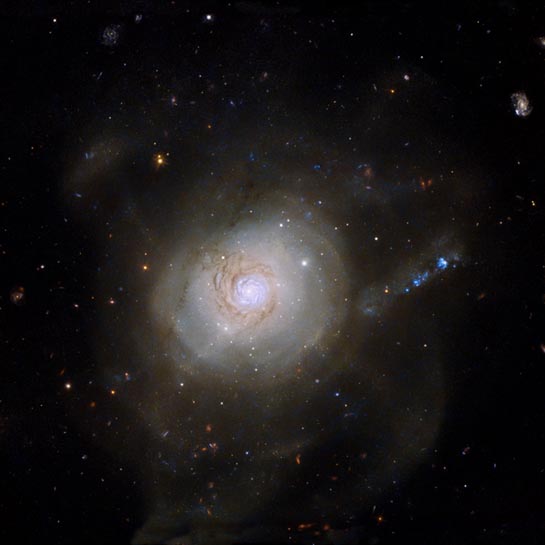
Interacting Galaxy
: RA 22h 20m 44.42s Dec -24° 40' 41.50"
Aquarius
220 million light-years
1.9' × 1.6' arc-min
12.7
2.22 x 2.11 arcminutes
North is 12.2° left of vertical
NASA & ESA, Ack: Judy Schmidt (Geckzilla)
December 7, 2015
Wider view: G1044
ABOUT THIS IMAGE:
Only rarely does an astronomical object have a political association. However, the spiral galaxy NGC 7252 acquired exactly that when it was given an unusual nickname. It was first discovered by William Herschel on October 26, 1785.
In December 1953, President Dwight D. Eisenhower gave a speech advocating the use of nuclear power for peaceful purposes. This "Atoms for Peace" speech was significant for the scientific community, as it brought nuclear research into the public domain, and NGC 7252, which has a superficial resemblance to an atomic nucleus surrounded by the loops of electronic orbits, was dubbed the Atoms for Peace galaxy in honor of this. These loops are well visible in a wider field of view image.
This nickname is quite ironic, as the galaxy's past was anything but peaceful. Its peculiar appearance is the result of a collision between two galaxies that took place about a billion years ago, which ripped both galaxies apart. The loop-like outer structures, likely made up of dust and stars flung outwards by the crash, but recalling orbiting electrons in an atom, are partly responsible for the galaxy's nickname.
This
NASA/ESA Hubble Space Telescope image shows the inner parts of the galaxy,
revealing a pinwheel-shaped disc that is rotating in a direction opposite
to the rest of the galaxy. This disc resembles a spiral galaxy like our
own galaxy, the Milky Way, but is only about 10 000 light-years across
- about a tenth of the size of the Milky Way. It is believed that this
whirling structure is a remnant of the galactic collision. It will most
likely have vanished in a few billion years' time, when NGC 7252 will
have completed its merging process.